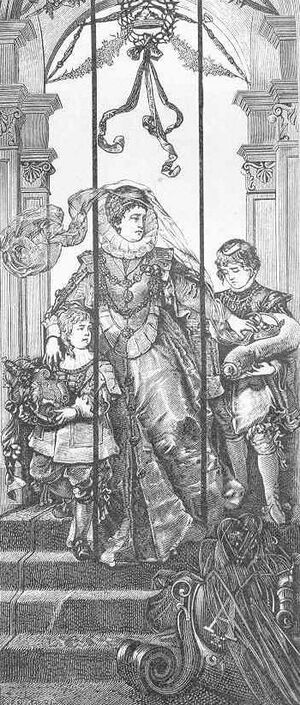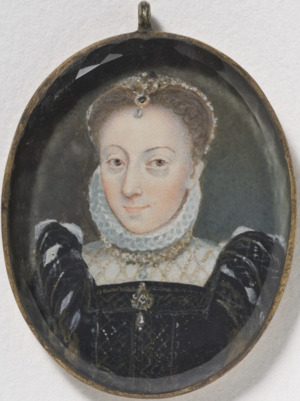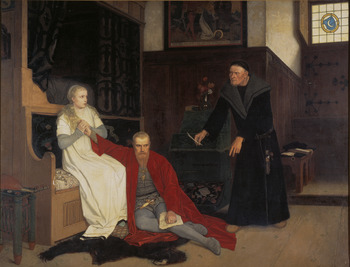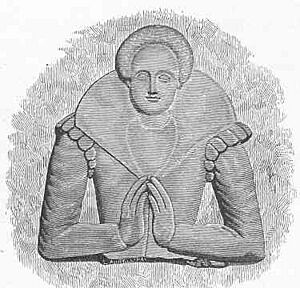Karin Månsdotter facts for kids
Quick facts for kids Karin Månsdotter |
|
|---|---|

Queen Catherine as drawn
by her husband in prison |
|
| Queen consort of Sweden | |
| Tenure | 4 July 1568 – January 1569 |
| Born | 6 November 1550 Stockholm, Uppland, Sweden |
| Died | 13 September 1612 (aged 61) Kangasala, Finland |
| Burial | Turku Cathedral, Turku, Finland |
| Spouse | Eric XIV of Sweden |
| Issue | Sigrid Eriksdotter Vasa Gustav Eriksson Vasa |
| Father | Måns |
| Mother | Ingrid |
Karin Månsdotter (also known as Catherine in English) was born on November 6, 1550. She became the special companion and later the Queen of King Eric XIV of Sweden. She passed away on September 13, 1612.
Contents
Early Life and Royal Connection
Karin was born in Stockholm. Her father, Måns, was a soldier and later a prison guard. Her last name, Månsdotter, means "daughter of Måns." Her mother, Ingrid, came from a farming family in Uppland. Some stories say her mother sold vegetables. Both her parents likely died around 1560.
King Eric XIV first noticed Karin around 1564. She was working as a servant for the wife of the king's musician, Gert Cantor. She later became a maid for the king's sister, Princess Elizabeth. In 1565, she became a special companion to King Eric.
Life as the King's Companion
Karin's role with King Eric became very important. She received expensive clothes and had her own apartment and servants. She even had her former employer, Gert Cantor's wife, working for her. When her daughter Sigrid was born in 1566, she was treated like a princess. Before Karin, the king had other companions, but he focused only on Karin after she came into his life. She also learned to read and write.
People at the time were surprised by how much the king cared for Karin. Some even thought she used magic to keep his affection. Karin was described as very beautiful with long blond hair. She was known for being calm and humble. The king sometimes struggled with his mental health, and Karin seemed to be the only one who could comfort him. This made his family appreciate her.
Karin's Influence and Challenges
Karin's friends at court often asked her to speak to the king for them. She tried her best to help. One example happened in May 1567, when the king was very unwell. He imprisoned several nobles, including Count Svante Sture. Countess Märta Sture asked Karin to protect the prisoners. Karin promised they would be safe. However, the prisoners were executed later that day. The king then disappeared, and Karin helped search for him.
Karin also gave gifts to the Vadstena Abbey (a religious community) several times. Her biggest gift was during the king's illness in 1567.
Becoming Queen of Sweden

In 1567, King Eric decided to marry Karin. This was a big step because she was not from a royal or noble family. His advisor, Jöran Persson, supported the idea. The first secret wedding happened on December 29, 1567. During this time, the king was still dealing with mental health issues.
Rumors spread about the marriage. Some people thought Karin used magic to control the king. Jöran Persson's wife, Anna Andersdotter, was accused of spreading these rumors. Karin herself asked for Anna to be pardoned. When the king recovered, Karin helped him make peace with his brother, Duke John.
On February 10, 1568, Karin was officially given the title of queen. She signed documents as "Chosen Queen," showing she knew her position was not fully accepted by everyone. The king's brothers and other enemies did not attend the wedding.
The Royal Wedding and Coronation
The official wedding took place on July 4, 1568, in Stockholm. The next day, Karin was crowned queen. This wedding was special because the couple's children were present. Their young son and daughter stood under a special banner with their parents. This showed that their children were also officially recognized.
Karin's relatives, who were farmers from Uppland, attended the coronation. They wore special clothes made for them by the royal tailor. During the crowning ceremony, something unusual happened. The Lord Chancellor fainted and dropped the crown. Some people saw this as a bad sign.
As queen, Karin gave gifts to her friends and family. She also made decisions about royal lands, which was usually done by monarchs. This showed her growing influence. Soon after the coronation, the king's brothers rebelled, and King Eric was imprisoned.
Life in Prison
Karin was imprisoned with King Eric in several castles. These included the Royal Palace of Stockholm, Castle of Turku, Kastelholm Castle, Gripsholm Castle, and Västerås Castle. Their children were first cared for by others but reunited with them in 1570. Karin gave birth to two more children while in prison, but sadly, both died there.
During their imprisonment, Karin reportedly told Eric that his past actions had led to their current situation. In 1569, some people tried to free the king and queen. Karin's head lady-in-waiting and her secretary were involved. The plan was discovered, and they were executed.
On June 14, 1573, Karin and her children were separated from King Eric. This was done to prevent them from having more children. King Eric wrote in his diary that his wife was taken from him by force. Karin and her children were moved to the Castle of Turku in Finland. She remained under house arrest until Eric's death four years later. In 1575, her son was taken from her and sent to Poland. She was allowed to keep her daughter. In 1577, she learned of her husband's death. She was then given a royal estate called Liuksiala Manor in Finland, where she lived for the rest of her life.
Later Life as a Widow

Karin Månsdotter visited the Swedish court twice after becoming a widow. In 1577, she asked for financial help, which she received. In 1582, she met with Queen Catherine Jagiellon and the former queen Catherine Stenbock. This meeting was called "The Meeting of Three Queens Catherine."
In 1587, her daughter Sigrid became a lady-in-waiting to Princess Anna. Karin traveled with her daughter to Warsaw, Poland. There, she met her son Gustaf again after 12 years. She saw him once more in Estonia in 1595. By then, he had become Catholic and had forgotten Swedish, the only language Karin spoke. She could only recognize him by his birthmarks. He was poor and worked as a soldier. Karin tried to help him financially and spent the rest of her life trying to get him permission to return to Sweden. She never saw him again. Her daughter Sigrid, however, married two Swedish noblemen and often visited her mother.
Karin became respected in Finland. During a peasant rebellion in 1596–97, the rebels did not harm her estate. She was also very good at managing her property. By 1587, Liuksiala Manor was one of the most profitable estates in Finland. She remained neutral during conflicts in Finland.
In 1606, Karin asked King Charles IX for permission to use her tenants' tax money to free her son, who was a prisoner in Russia. The king refused. In 1607, Karin told her tenants not to pay royal taxes. The king sent representatives to explain this was not allowed. Soon after, her son died in captivity.
Karin died peacefully after an illness at Liuksiala. She is buried in the Cathedral of Turku. Karin Månsdotter was a unique queen because she was a commoner who married a king. This was very rare for a Swedish queen until much later.
Family
Karin Månsdotter had the following children with King Eric XIV:
- Princess Sigrid of Sweden (1566–1633): Born before her parents' marriage, she became a lady-in-waiting and married two nobles.
- Prince Gustav of Sweden (1568–1607): Also born before the marriage, he later became a soldier.
- Henrik (1570–1574)
- Arnold (1572–1573)
Karin Månsdotter in Stories
Karin Månsdotter has been featured in movies and books. The film Karin Månsdotter was made in 1954. Finnish author Mika Waltari wrote a historical novel about her in 1942.
Legacy
The asteroid 832 Karin is named in her honor.






